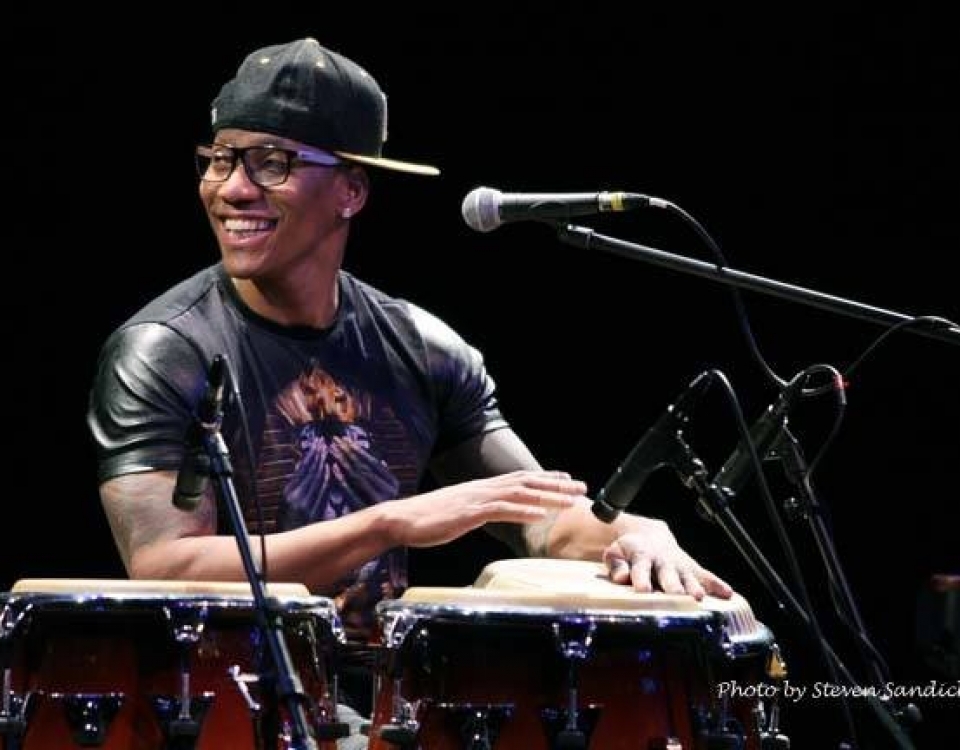 Play, Sing, Dance the Distance from Havana to New York
Play, Sing, Dance the Distance from Havana to New York
It was just over a month ago when President Obama announced that the United States would restore diplomatic relations with Cuba. Diplomatic relations between two countries separated by only 90 miles of sea had not been in place since before the President was born.
“Perfect!” Landmark’s then-Director Sharon Maier-Kennelly (B.A. SUNY Binghamton, Spanish) must have said. She was surely party to the negotiations between Presidents Obama, Castro and Pope Francis. She instantly knew that the timing for a Pedrito Martinez appearance in a town named for an earlier President would never be better.
See Steven Sandick’s photography from the event.
Last night, Mr. Martinez, front and center with his three-bongo set, partnered with bassist Alvaro Benavides, percussionist Jhair Sala, and keyboardist Edgar Pantoja-Aleman to bring a buoyant dose of Afro-Cuban diplomacy to Port Washington’s Landmark venue. The timing and the tempo were upbeat – and well suited to the short-sleeved musicians’ blend of NYC and the warmer climes of the Caribbean island.
The Music
Many in the enthusiastic Landmark audience needed no coaxing to take to the floor, where they often remained for the duration of the improvisation-rich songs. Likely chosen and orchestrated by Pedrito Martinez himself, according to Mr. Sala, who dubbed him the group’s “mastermind.”
Some in the audience of a certain age were likely introduced to hot-blooded genre by another Havana native, Gloria Estefan and the Miami Sound Machine, but there’s a lot more than the legendary vocalist to the history of Afro-Cuban music. There’s Rubén Blades and many other musicians not known to many US listeners. Yet it is a genre that has developed over two hundred years – tapping into elements of jazz, African music, flamenco. Its early roots even enveloped Catholic liturgical music and the “contradanse,” derived from French and Spanish predecessors. The Wikipedia page on Cuban Music is a good place to start, tracing Cuban music roots back to the 1700’s.
From the balcony it was easy to appreciate ambassador Pantoja-Aleman race through his jazz-inflected Yamaha montuno (or tumbao) keyboard patterns. As the evening’s only true melody instrument apart from the vocals, his two keyboards provided the harmonic floor for the evening’s festivities – and plenty of the rhythm, too. He did this to great effect, using different keyboard voices and playing styles – even a passage he sang and played using a Korg “Talkbox” effect. In several songs he also made liberal use of scat singing, doubling his voice with right hand piano notes.
Huge fans of this music might consider learning some of the keyboard basics, which these days can be had on YouTube, such as those produced by “Piano52Weeks.” Played slow, there’s excellent low-hanging fruit for beginners. Play fast and gain added appreciation for Mr. Pantoja-Aleman’s sturdy right hand delivery.
The keyboard contribution was essential – it was musical plumbing, foundation. At center stage, though, literally and figuratively, was Martinez, who waited until the third song to cut loose with the first of many compelling conga solos. His hand speed impressed – it’s the virtuoso that got us out of our chairs into the cold night — but the musicality of his cadences and witty dynamics were more so. There’s a world of hidden technique required to play the conga, and when a gifted artist like Martinez plays, that world remains wholly hidden. If your plan was to decipher the Guaguancó or rumba influences from a single evening’s listening . . . Well, at least you had a great time dancing.
Bassist Alvaro Benavides, originally from Venezuela (also in need of diplomatic treatment) provided a danceable rumble from his 5-string Steinberger (?) bass with slaps, slides and generally sly rhythms. Second percussionist Sala, originally Peruvian and less in need of a diplomatic intervention, proved there is more to cowbell (and the occasional bongo) than “(Don’t Fear) The Reaper,” which in this genre can be downright tricky.
All four sang throughout, with Martinez carrying the lead burden.
Memo from the State Department: RE Cultural Affairs
The Landmark audience filed out with smiles all around. Overheard on the way out: “Honey, do you think I could learn to play the bongos?” Not a bad idea, Secretary Carey.
One other tip, Mr. Secretary. Get out your dancing shoes. Toss out the lockstep ideas and be ready to syncopate. A Caribbean rapprochement involving this brand of music won’t be conducted sitting down.
And it’s congas (in Cuba, tumbadora) not bongos.
The next performance at Landmark will feature Jonathan Groff, currently starring in the HBO TV series Looking.
Image credits: Michael Weintrob, Steven Sandick (gallery)


